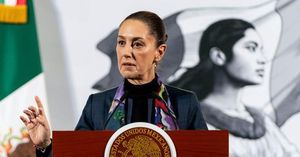Images from the James Webb Space Telescope (JWST) have dazzled astronomers and casual stargazers alike, but they are also raising more questions than answers about the early Universe. This groundbreaking telescope, launched on Christmas Day 2021, has begun to unravel the cosmic history, but the findings so far seem to challenge long-held beliefs.
JWST's massive mirror, which is five times larger than the Hubble Space Telescope's, was built to peer deep back in time to when the very first galaxies formed. Surprisingly, instead of detecting newborn galaxies, researchers found what appeared to be fully-formed 'adult-sized' galaxies at these early epochs.
Such findings have sent scientists scurrying to reassess the established models of cosmic history. If instead of small toddler-like galaxies, the observations suggest these are fully-formed galaxies, then there’s something fundamentally flawed with our current astronomical theories.
This is not the only discrepancy arising from JWST data. The rate at which the Universe is currently perceived to be growing appears to conflict with earlier measurements and expectations, creating what scientists call 'Hubble tension.'
The Hubble tension refers to the differences between two methodologies for calculating the Hubble constant – the rate of the Universe's expansion. Researchers have previously used distant cosmic events to derive values and have measured expansion rates both from the Cosmic Microwave Background (CMB) and local astronomical objects.
Traditionally, the CMB method has produced more accurate values, estimating the expansion at about 67.4 kilometers per second per megaparsec. On the other hand, observations of nearby galaxies produced higher estimates around 74 kilometers per second per megaparsec, creating a gap between expectations and reality.
With JWST expected to clarify these mysteries, initial findings have only deepened them, leading to more questions. While scientists had anticipated the telescope's advanced capabilities would harmonize these two measurement approaches, its revelations seem to have widened the gap even more.
Wendy Freedman, cosmologist at the University of Chicago, worked on the JWST data and expressed initial optimism. After analyzing the distances to ten nearby galaxies using the telescope's detailed imaging, her team found results indicating values more similar to the CMB method.
Freedman’s findings state the Hubble Constant derived from JWST data is approximately 70 kilometers per second per megaparsec, which falls much closer to the CMB estimates. Freedman commented, “Confirming the reality of the Hubble stress would have significant consequences for fundamental physics and modern cosmology.”
Another line of inquiry emerges from the very infancy of our Universe, where JWST has challenged assumptions by showing advanced galaxies seemingly appearing shortly after the Big Bang. Rather than the expected small formations of stars, astronomers found expansive galaxies filled with billions of bright stars from around 13 billion years ago.
This astonishing discovery evokes imagery akin to “adults playing in kindergarten,” as it paints an entirely different picture of the Universe's early development than previously envisaged. Researchers now grapple with explaining how such prolific star formation could occur so early.
The early history of the Universe remains obscured by gaps and inconsistencies, inviting scientists to reconsider the standard model of cosmology. For decades, this standard model has been admired for its elegance and simplicity yet has required various patchwork fixes to accommodate conflicting data.
One such fix has been the concept of dark matter, which serves to solve discrepancies between what we observe and the gravitational pull of matter. Another fix has been dark energy, which attempts to explain the Universe's accelerating expansion, yet this remains poorly understood.
The scientific community is currently at what could be termed the 'crossroads of knowledge.' Many researchers argue these puzzling JWST findings might signify something more serious than mere achievable fixes; they could represent fundamental issues with our cosmic models.
Scientific theories stand on the shoulders of past observations, yet when new evidence emerges, as seen through JWST, routine adjustments may not suffice. Instead, this may be the point at which longstanding models need comprehensive revisions.
The established narrative of expansion and formation of galaxies, which previously seemed grounded, is now vulnerable to scrutiny. Possible interpretations of JWST findings, rather than patched-up models, suggest the very structure of cosmic history might be poised for reassessment.
Science’s history is filled with thinkers holding fast to traditional models until overwhelming evidence causes shifts. Could the unexpected results from JWST lead to another such tectonic change, or will they be relegated to just another layer of complexity within the existing framework?
Time will tell. Looking forward, the astronomic field anticipates more observations from the JWST will shed light on how cosmic history really developed.



